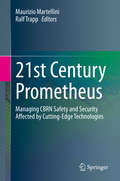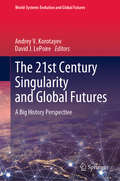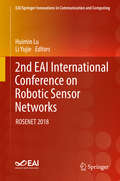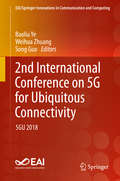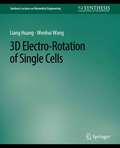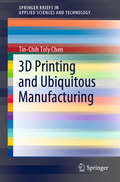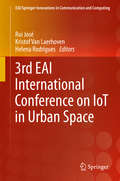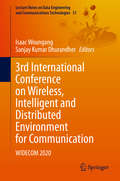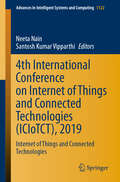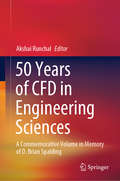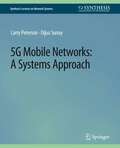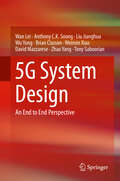- Table View
- List View
21st Century Nanoscience – A Handbook: Design Strategies for Synthesis and Fabrication (Volume Two) (21st Century Nanoscience)
by Klaus D. SattlerThis up-to-date reference is the most comprehensive summary of the field of nanoscience and its applications. It begins with fundamental properties at the nanoscale and then goes well beyond into the practical aspects of the design, synthesis, and use of nanomaterials in various industries. It emphasizes the vast strides made in the field over the past decade – the chapters focus on new, promising directions as well as emerging theoretical and experimental methods. The contents incorporate experimental data and graphs where appropriate, as well as supporting tables and figures with a tutorial approach.
21st Century Prometheus: Managing CBRN Safety and Security Affected by Cutting-Edge Technologies
by Maurizio Martellini Ralf TrappThis book describes the evolving CBRN risk landscape and highlights advances in the “core” CBRN technologies, including when combined with (improvised) explosive devices (CBRNe threats). It analyses how associated technologies create new safety and security risks, challenging certain assumptions that underlie current control regimes. The book also shows how technologies can be enablers for more effective strategies to mitigate these risks.21st-century safety and security risks emanating from chemical, biological, radiological and nuclear materials – whether resulting from natural events, accidents or malevolent use - are increasingly shaped by technologies that enable their development, production or use in ways that differ from the past. Artificial intelligence, the use of cyberspace, the revolution in the life sciences, new manufacturing methods, new platforms and equipment for agent delivery, hypersonic weapons systems, information tools utilised in hybrid warfare – these and other technologies are reshaping the global security environment and CBRN landscape. They are leading to a growing potential for highly targeted violence, and they can lead to greater instability and vulnerability worldwide. At the same time, technology offers solutions to manage CBRN risks. Examples are faster detection, more accurate characterisation of the nature and origin of CBRN agents, new forensic investigation methods, or new medical treatments for victims of CBRN incidents. New educational concepts help to foster a culture of responsibility in science and technology and strengthen governance. New training methods help develop practical skills to manage CBRN risks more effectively.The book concludes that there is a growing need for a holistic framework towards CBRN risk mitigation. Traditional arms control mechanisms such as global, regional or bilateral treaties and export controls are still needed, as they provide a necessary legal and institutional framework. But laws and technology denial alone will not suffice, and institutional mechanisms can at times be weak. Given the pace of technological progress and the diffusion of critical knowledge, tools and materials, policymakers must accept that CBRN risks cannot be eliminated altogether. Instead, society has to learn to manage these risks and develop resilience against them. This requires a “softer”, broadly based multi-stakeholder approach involving governments, industry, the research and development communities, educators, and civil society. Furthermore, educating policymakers that cutting-edge technologies may seriously affect global strategic stability could create incentives for developing a more creative and contemporary arms control strategy that fosters cooperation rather than incremental polarisation.
The 21st Century Singularity and Global Futures: A Big History Perspective (World-Systems Evolution and Global Futures)
by Andrey V. Korotayev David J. LePoireThis book introduces a 'Big History' perspective to understand the acceleration of social, technological and economic trends towards a near-term singularity, marking a radical turning point in the evolution of our planet. It traces the emergence of accelerating innovation rates through global history and highlights major historical transformations throughout the evolution of life, humans, and civilization. The authors pursue an interdisciplinary approach, also drawing on concepts from physics and evolutionary biology, to offer potential models of the underlying mechanisms driving this acceleration, along with potential clues on how it might progress. The contributions gathered here are divided into five parts, the first of which studies historical mega-trends in relation to a variety of aspects including technology, population, energy, and information. The second part is dedicated to a variety of models that can help understand the potential mechanisms, and support extrapolation. In turn, the third part explores various potential future scenarios, along with the paths and decisions that are required. The fourth part presents philosophical perspectives on the potential deeper meaning and implications of the trend towards singularity, while the fifth and last part discusses the implications of the Search for Extraterrestrial Intelligence (SETI). Given its scope, the book will appeal to scholars from various disciplines interested in historical trends, technological change and evolutionary processes.
2D Monoelements: Properties and Applications
by Inamuddin Rajender Boddula Mohd Imran Ahamed Abdullah M. Asiri2D Monoelements: Properties and Applications explores the challenges, research progress and future developments of the basic idea of two-dimensional monoelements, classifications, and application in field-effect transistors for sensing and biosensing. The thematic topics include investigations such as: Recent advances in phosphorene The diverse properties of two-dimensional antimonene, of graphene and its derivatives The molecular docking simulation study used to analyze the binding mechanisms of graphene oxide as a cancer drug carrier Metal-organic frameworks (MOFs)-derived carbon (graphene and carbon nanotubes) and MOF-carbon composite materials, with a special emphasis on the use of these nanostructures for energy storage devices (supercapacitors) Two-dimensional monoelements classification like graphene application in field-effect transistors for sensing and biosensing Graphene-based ternary materials as a supercapacitor electrode Rise of silicene and its applications in gas sensing
2D Monoelements: Properties and Applications
by Rajender Boddula Inamuddin Mohd Imran Ahamed Abdullah M. Asiri2D Monoelements: Properties and Applications explores the challenges, research progress and future developments of the basic idea of two-dimensional monoelements, classifications, and application in field-effect transistors for sensing and biosensing. The thematic topics include investigations such as: Recent advances in phosphorene The diverse properties of two-dimensional antimonene, of graphene and its derivatives The molecular docking simulation study used to analyze the binding mechanisms of graphene oxide as a cancer drug carrier Metal-organic frameworks (MOFs)-derived carbon (graphene and carbon nanotubes) and MOF-carbon composite materials, with a special emphasis on the use of these nanostructures for energy storage devices (supercapacitors) Two-dimensional monoelements classification like graphene application in field-effect transistors for sensing and biosensing Graphene-based ternary materials as a supercapacitor electrode Rise of silicene and its applications in gas sensing
2nd EAI International Conference on Robotic Sensor Networks: ROSENET 2018 (EAI/Springer Innovations in Communication and Computing)
by Huimin Lu Li YujieThis book provides scientific research into Cognitive Internet of Things for Smart Society, with papers presented at the 2nd EAI International Conference on Robotic Sensor Networks. The conference explores the integration of networks and robotic technologies, which has become a topic of increasing interest for both researchers and developers from academic fields and industries worldwide. The authors posit that big networks will be the main approach to the next generation of robotic research, with the explosive number of networks models and increasing computational power of computers significantly extending the number of potential applications for robotic technologies while also bringing new challenges to the network's community. The 2nd EAI International Conference on Robotic Sensor Networks was held 25-26 August 2018 at the Kitakyushu International Conference Center (MICE), Kitakyushu, Japan.
2nd International Conference on 5G for Ubiquitous Connectivity: 5GU 2018 (EAI/Springer Innovations in Communication and Computing)
by Baoliu Ye Weihua Zhuang Song GuoThe book presents the proceedings of the 2nd International Conference on 5G for Ubiquitous Connectivity (5GU 2018), which took place on December 4-5, 2018 in Nanjing, People’s Republic of China. The aim of this conference is to bring together researchers and developers as well as regulators and policy makers to present their latest views on 5G, including new networking, new wireless communications, resource control & management, future access techniques, new emerging applications, and latest findings in key research activities on 5G. The book is applicable to researchers, academics, students, and professionals.Features practical, tested applications in 5G for ubiquitous connectivity;Includes discussion of 5G for ubiquitous connectivity in relation to wireless communications, resource control & management, and future access techniques;Applicable to researchers, academics, students, and professionals.
30th Scientific-Experts Conference of Agriculture and Food Industry: Answers for Forthcoming Challenges in Modern Agriculture (IFMBE Proceedings #78)
by Enisa Omanović-Mikličanin Muhamed Brka Lutvija Karić Vedad Falan Almir ToromanThis book gathers the proceedings of the 30th Scientific-Experts Conference of Agriculture and Food Industry, held on September 26-27, 2019, in Sarajevo, Bosnia and Herzegovina. It reports on the application of innovative technologies in food sciences and agriculture, and covers research in plant and animal production, agricultural economics and food production. Further, the book discusses key social and environmental issues, and proposes answers to current challenges. The conference was jointly organized by the Faculty of Agriculture and Food Sciences of the University of Sarajevo, Bosnia and Herzegovina, the Faculty of Agriculture of Ege University, Turkey, the Bosnia and Herzegovina Medical and Biological Engineering Society, and the Faculty of Agriculture of the University of Belgrade, Serbia. The proceedings offer a timely snapshot of cutting-edge, multidisciplinary research and developments in modern agriculture. As such, they address the needs of researchers and professionals, agricultural companies, food producers, and regulatory and food safety agencies.
The 30th SIAR International Congress of Automotive and Transport Engineering: Science and Management of Automotive and Transportation Engineering
by Ilie Dumitru Dinu Covaciu Laurențiu Racila Adrian RoscaThis proceedings book includes papers that cover the latest developments in automotive vehicles and environment, advanced transport systems and road traffic, heavy and special vehicles, new materials, manufacturing technologies and logistics and advanced engineering methods. Authors of the papers selected for this book are experts from research, industry and universities, coming from different countries. The overall objectives of the presentations are to respond to the major challenges faced by the automotive industry, and to propose potential solutions to problems related to automotive technology, transportation and environment, and road safety.The congress is organized by SIAR (Society of Automotive Engineers from Romania) in cooperation with SAE International. The purpose is to gather members from academia, industry and government and present their possibilities for investigations and research, in order to establish new future collaborations in the automotive engineering and transport domain. This proceedings book is just a part of the outcomes of the congress.The results presented in this proceedings book benefit researchers from academia and research institutes, industry specialists, Ph.D. students and students in Automotive and Transport Engineering programs.
3D Electro-Rotation of Single Cells (Synthesis Lectures on Biomedical Engineering)
by Liang Huang Guido Buonincontri Wenhui WangDielectrophoresis microfluidic chips have been widely used in various biological applications due to their advantages of convenient operation, high throughput, and low cost. However, most of the DEP microfluidic chips are based on 2D planar electrodes which have some limitations, such as electric field attenuation, small effective working regions, and weak DEP forces. In order to overcome the limitations of 2D planar electrodes, two kinds of thick-electrode DEP chips were designed to realize manipulation and multi-parameter measurement of single cells. Based on the multi-electrode structure of thick-electrode DEP, a single-cell 3D electro-rotation chip of "Armillary Sphere" was designed. The chip uses four thick electrodes and a bottom planar electrode to form an electric field chamber, which can control 3D rotation of single cells under different electric signal configurations. Electrical property measurement and 3D image reconstruction of single cells are achieved based on single-cell 3D rotation. This work overcomes the limitations of 2D planar electrodes and effectively solves the problem of unstable spatial position of single-cell samples, and provides a new platform for single-cell analysis. Based on multi-electrode structure of thick-electrode DEP, a microfluidic chip with optoelectronic integration was presented. A dual-fiber optical stretcher embedded in thick electrodes can trap and stretch a single cell while the thick electrodes are used for single-cell rotation. Stretching and rotation manipulation gives the chip the ability to simultaneously measure mechanical and electrical properties of single cells, providing a versatile platform for single-cell analysis, further extending the application of thick-electrode DEP in biological manipulation and analysis.
3D Printing and Ubiquitous Manufacturing (SpringerBriefs in Applied Sciences and Technology)
by Tin-Chih Toly ChenThis book provides a thorough overview of the applications of 3D printing technologies to ubiquitous manufacturing (UM). UM itself represents an application of ubiquitous computing in the manufacturing sector, and this book reveals how it offers convenient, on-demand network access to a shared pool of configurable manufacturing resources, including software tools, equipment, and capabilities. Given its scope, the book will be of considerable interest to researchers in the areas of manufacturing, mechanical engineering, operations management, production control, ubiquitous computing, and sensor technologies, as well as practicing managers and engineers.
3D Printing in Biomedical Engineering (Materials Horizons: From Nature to Nanomaterials)
by Sunpreet Singh Chander Prakash Rupinder SinghThis book gives a comprehensive overview of the rapidly evolving field of three-dimensional (3D) printing, and its increasing applications in the biomedical domain. 3D printing has distinct advantages like improved quality, cost-effectiveness, and higher efficiency compared to traditional manufacturing processes. Besides these advantages, current challenges and opportunities regarding choice of material, design, and efficiency are addressed in the book. Individual chapters also focus on select areas of applications such as surgical guides, tissue regeneration, artificial scaffolds and implants, and drug delivery and release. This book will be a valuable source of information for researchers and professionals interested in the expanding biomedical applications of 3D printing.
3rd EAI International Conference on IoT in Urban Space (EAI/Springer Innovations in Communication and Computing)
by Rui José Kristof Van Laerhoven Helena RodriguesThis proceedings presents the papers from Urb-IoT 2018 - 3rd EAI International Conference on IoT in Urban Space, which took place in Guimarães, Portugal on 21-22 November 2018. The conference aims to explore the emerging dynamics within the scope of the Internet of Things (IoT) and the new science of cities.The papers discuss fusion of heterogeneous urban sources, understanding urban data using machine learning and mining techniques, urban analytics, urban IoT infrastructures, crowd sourcing techniques, incentification and gamification, urban mobility and intelligent transportation systems, real time urban information systems, and more. The proceedings discuss innovative technologies that navigate industry and connectivity sectors in transportation, utility, public safety, healthcare, and education. The authors also discuss the increasing deployments of IoT technologies and the rise of the so-called 'Sensored Cities'‚ which are opening up new avenues of research opportunities towards that future.
3rd International Conference on the Application of Superabsorbent Polymers (RILEM Bookseries #24)
by William P. Boshoff Riaan Combrinck Viktor Mechtcherine Mateusz WyrzykowskiThe book gathers the peer-reviewed contributions presented at the 3rd International Conference on Application of Superabsorbent Polymers (SAP) and Other New Admixtures towards Smart Concrete, held in Skukuza, South Africa, on November 25-27, 2019. It features papers focusing on the behavior of SAP in concrete (in particular the absorption behavior) as well as the effect of SAP on fresh and hardened concrete properties. It also covers topics such as other modern admixtures, in particular rheology-modifying admixtures, including the recently emerging field of bio- or waste-derived admixtures. The conference builds on the experience and summarizes the activities of the RILEM Technical Committee 260-RSC "Recommendations for Use of Superabsorbent Polymers in Concrete Construction" and addresses other prominent research activities in the field of concrete admixtures.
3rd International Conference on Wireless, Intelligent and Distributed Environment for Communication: WIDECOM 2020 (Lecture Notes on Data Engineering and Communications Technologies #51)
by Isaac Woungang Sanjay Kumar DhurandherThis book presents the proceedings of the 3rd International Conference on Wireless Intelligent and Distributed Environment for Communication (WIDECOM 2020), sponsored by Ryerson University, Toronto, Canada, May 6-8, 2020. The WIDECOM conference solicits papers addressing issues related to new dependability paradigms, design, and performance of dependable network computing and mobile systems, as well as issues related to the security of these systems. The goal of the conference is to provide a forum for researchers, students, scientists and engineers working in academia and industry to share their experiences, new ideas and research results in the above-mentioned areas.Presents the proceedings of the International Conference on Wireless Intelligent and Distributed Environment for Communication (WIDECOM 2020), Ryerson University, Toronto, Canada, May 6-8, 2020;Includes an array of topics networking computing, mobile/ubiquitous systems, cloud systems, and IoT systems;Addresses issues related to protecting information security and establishing trust in the digital space.
4th EAI International Conference on Management of Manufacturing Systems: MMS 2019 (EAI/Springer Innovations in Communication and Computing)
by Lucia Knapcikova Michal Balog Dragan Perakovic Marko PerisaThe book presents the proceedings of the 4th EAI International Conference on Management of Manufacturing Systems (MMS 2019), which took place in Krynica Zdroj, Poland, on October 8-10, 2019. The conference covered Management of Manufacturing Systems with support for Industry 4.0, Logistics and Intelligent Manufacturing Systems and Applications, Cooperation management and its effective applications. Topics include RFID Applications, Economic Impacts in Logistics, ICT Support for Industry 4.0, Industrial and Smart Logistics, Intelligent Manufacturing Systems and Applications, and much more.
4th International Conference on Computational Mathematics and Engineering Sciences (Advances in Intelligent Systems and Computing #1111)
by Hemen Dutta Zakia Hammouch Hasan Bulut Haci Mehmet BaskonusThis book gathers original research papers presented at the 4th International Conference on Computational Mathematics and Engineering Sciences, held at Akdeniz University, Antalya, Turkey, on 20–22 April 2019. Focusing on computational methods in science, mathematical tools applied to engineering, mathematical modeling and new aspects of analysis, the book discusses the applications of mathematical modelling in areas such as health science, engineering, computer science, social science, and economics. It also describes a wide variety of analytical, computational, and numerical methods. The conference aimed to foster cooperation between students and researchers in the areas of computational mathematics and engineering sciences, and provide a platform for them to share significant research ideas. This book is a valuable resource for graduate students, researchers and educators interested in the mathematical tools and techniques required for solving various problems arising in science and engineering, and understanding new methods and uses of mathematical analysis.
4th International Conference on Internet of Things and Connected Technologies: Internet of Things and Connected Technologies (Advances in Intelligent Systems and Computing #1122)
by Neeta Nain Santosh Kumar VipparthiThis book presents the proceedings of the 4th International Conference on Internet of Things and Connected Technologies (ICIoTCT), held on May 9–10, 2019, at Malaviya National Institute of Technology (MNIT), Jaipur, India. The Internet of Things (IoT) promises to usher in a revolutionary, fully interconnected “smart” world, with relationships between objects and their environment and objects and people becoming more tightly intertwined. The prospect of the Internet of Things as a ubiquitous array of devices bound to the Internet could fundamentally change how people think about what it means to be “online”. The ICIotCT 2019 conference provided a platform to discuss advances in Internet of Things (IoT) and connected technologies, such as various protocols and standards. It also offered participants the opportunity to interact with experts through keynote talks, paper presentations and discussions, and as such stimulated research. With the recent adoption of a variety of enabling wireless communication technologies, like RFID tags, BLE, ZigBee, embedded sensor and actuator nodes, and various protocols such as CoAP, MQTT and DNS, IoT has moved on from its infancy. Today smart sensors can collaborate directly with machines to automate decision-making or to control a task without human involvement. Further, smart technologies, including green electronics, green radios, fuzzy neural approaches, and intelligent signal processing techniques play an important role in the development of the wearable healthcare devices.
4th International Conference on Nanotechnologies and Biomedical Engineering: Proceedings of ICNBME-2019, September 18-21, 2019, Chisinau, Moldova (IFMBE Proceedings #77)
by Ion Tiginyanu Victor Sontea Serghei RaileanThis book gathers the proceedings of the 4th International Conference on Nanotechnologies and Biomedical Engineering, held on September 18-21, 2019, in Chisinau, Republic of Moldova. It continues the tradition of the previous conference proceedings, thus reporting on both fundamental and applied research at the interface between nanotechnologies and biomedical engineering. Topics include: developments in bio-micro/nanotechnologies and devices; biomedical signal processing; biomedical imaging; biomaterials for biomedical applications; biomimetics; bioinformatics and e-health, and advances in a number of related areas. The book offers a timely snapshot of cutting-edge, multidisciplinary research and developments in the field of biomedical and nano-engineering.
50 Years of CFD in Engineering Sciences: A Commemorative Volume in Memory of D. Brian Spalding
by Akshai RunchalProf. D. Brian Spalding, working with a small group of students and colleagues at Imperial College, London in the mid-to late-1960’s, single-handedly pioneered the use of Computational Fluid Dynamics (CFD) for engineering practice.This book brings together advances in computational fluid dynamics in a collection of chapters authored by leading researchers, many of them students or associates of Prof. Spalding. The book intends to capture the key developments in specific fields of activity that have been transformed by application of CFD in the last 50 years. The focus is on review of the impact of CFD on these selected fields and of the novel applications that CFD has made possible. Some of the chapters trace the history of developments in a specific field and the role played by Spalding and his contributions. The volume also includes a biographical summary of Brian Spalding as a person and as a scientist, as well as tributes to Brian Spalding by those whose life was impacted by his innovations. This volume would be of special interest to researchers, practicing engineers, and graduate students in various fields, including aerospace, energy, power and propulsion, transportation, combustion, management of the environment, health and pharmaceutical sciences.
5G Mobile Networks: A Systems Approach (Synthesis Lectures on Network Systems)
by Larry PetersonThis book describes the 5G mobile network from a systems perspective, focusing on the fundamental design principles that are easily obscured by an overwhelming number of acronyms and standards definitions that dominate this space. The book is written for system generalists with the goal of helping bring up to speed a community that understands a broad range of systems issues (but knows little or nothing about the cellular network) so it can play a role in the network's evolution. This is a community that understands both feature velocity and best practices in building robust scalable systems, and so it has an important role to play in bringing to fruition all of 5G's potential. In addition to giving a step-by-step tour of the design rationale behind 5G, the book aggressively disaggregates the 5G mobile network. Building a disaggregated, virtualized, and software-defined 5G access network is the direction the industry is already headed (for good technical and business reasons), but breaking the 5G network down into its elemental components is also the best way to explain how 5G works. It also helps to illustrate how 5G might evolve in the future to provide even more value. An open source implementation of 5G serves as the technical underpinning for the book. The authors, in collaboration with industrial and academic partners, are working towards a cloud-based implementation that takes advantage of both Software-Defined Networking (SDN) and cloud-native (microservice-based) architectures, culminating in a managed 5G-enabled EdgeCloud-as-a-Service built on the components and mechanisms described throughout the book.
5G New Radio: A Beam-based Air Interface
by Mihai EnescuA guide to the 3GPP-specified 5G physical layer with a focus on the new beam-based dimension in the radio system 5G New Radio: A Beam-based Air Interface is an authoritative guide to the newly 3GPP-specified 5G physical layer. The contributors—noted experts on the topic and creators of the actual standard—focus on the beam-based operation which is a new dimension in the radio system due to the millimeter wave deployments of 5G. The book contains information that complements the 3GPP specification and helps to connect the dots regarding key features. The book assumes a basic knowledge of multi-antenna technologies and covers the physical layer aspects related to beam operation, such as initial access, details of reference signal design, beam management, and DL and UL data channel transmission. The contributors also provide a brief overview of standardization efforts, IMT-2020 submission, 5G spectrum, and performance analysis of 5G components. This important text: Contains information on the 3GPP-specified 5G physical layer Highlights the beam-based operation Covers the physical layer aspects related to beam operation Includes contributions from experts who created the standard Written for students and development engineers working with 5G NR, 5G New Radio: A Beam-based Air Interface offers an expert analysis of the 3GPP-specified 5G physical layer.
5G New Radio: A Beam-based Air Interface
by Mihai EnescuA guide to the 3GPP-specified 5G physical layer with a focus on the new beam-based dimension in the radio system 5G New Radio: A Beam-based Air Interface is an authoritative guide to the newly 3GPP-specified 5G physical layer. The contributors—noted experts on the topic and creators of the actual standard—focus on the beam-based operation which is a new dimension in the radio system due to the millimeter wave deployments of 5G. The book contains information that complements the 3GPP specification and helps to connect the dots regarding key features. The book assumes a basic knowledge of multi-antenna technologies and covers the physical layer aspects related to beam operation, such as initial access, details of reference signal design, beam management, and DL and UL data channel transmission. The contributors also provide a brief overview of standardization efforts, IMT-2020 submission, 5G spectrum, and performance analysis of 5G components. This important text: Contains information on the 3GPP-specified 5G physical layer Highlights the beam-based operation Covers the physical layer aspects related to beam operation Includes contributions from experts who created the standard Written for students and development engineers working with 5G NR, 5G New Radio: A Beam-based Air Interface offers an expert analysis of the 3GPP-specified 5G physical layer.
5G Radio Access Network Architecture: The Dark Side of 5G (Wiley - IEEE)
by Sasha SirotkinWritten by an industry insider with state of the art research at their fingertips, this book describes the Radio Access Network (RAN) architecture, starting with currently deployed 4G, followed by the description of 5G requirements and why re-thinking of the RAN architecture is needed to support these. Based on these considerations, it explains how 5G network architecture, which is currently being defined, is likely to evolve. The aim is not merely to cover relevant standards and technologies as a purely academic exercise (although a significant part of the book will be dedicated to these), but to augment these by practical deployment, to illustrate why the RAN architecture is changing and where it is going. With 5G deployments on the horizon, there is a desire within companies to both re-think the RAN architecture and to change the proprietary nature of the RAN. Correspondingly, there is increased interest in academia, standards bodies and commercial entities involved in the area.
5G System Design: An End to End Perspective
by Wan Lei Anthony C.K. Soong Liu Jianghua Wu Yong Brian Classon Weimin Xiao David Mazzarese Zhao Yang Tony SaboorianThis book presents a detailed pedagogical description of the 5G commercial wireless communication system design, from an end to end perspective. It compares and contrasts NR with LTE, and gives a concise and highly accessible description of the key technologies in the 5G physical layer, radio access network layer protocols and procedures. This book also illustrates how the 5G core and EPC is integrated into the radio access network, how virtualization and edge computer fundamentally change the way users interact with the network, as well as 5G spectrum issues.This book is structured into six chapters. The first chapter reviews the use cases, requirements, and standardization organization and activities for 5G. These are 5G requirements and not NR specifically, as technology that meets the requirements, may be submitted to the ITU as 5G technology. This includes a set of Radio Access Technologies (RATs), consisting of NR and LTE; with each RAT meeting different aspects of the requirements. The second chapter describes the air interface of NR and LTE side by side. The basic aspects of LTE that NR builds upon are first described, followed by sections on the NR specific technologies, such as carrier/channel, spectrum/duplexing (including SUL), LTE/NR co-existence and new physical layer technologies (including waveform, Polar/LDPC codes, MIMO, and URLLC/mMTC). In all cases the enhancements made relative to LTE are made apparent. The third chapter contains descriptions of NR procedures (IAM/Beam Management/Power control/HARQ), protocols (CP/UP/mobility, including grant-free), and RAN architecture. The fourth chapter includes a detailed discussion related to end-to-end system architecture, and the 5G Core (5GC), network slicing, service continuity, relation to EPC, network virtualization, and edge computing. The fifth and major chapter describes the ITU submission and how NR and LTE meet the 5G requirements in significant detail, from the rapporteur responsible for leading the preparation and evaluation, as well as some field trial results.Engineers, computer scientists and professionals with a passing knowledge of 4G LTE and a comprehensive understanding of the end to end 5G commercial wireless system will find this book to be a valuable asset. Advanced-level students and researchers studying and working in communication engineering, who want to gain an understanding of the 5G system (as well as methodologies to evaluate features and technologies intended to supplement 5G) will also find this book to be a valuable resource.

